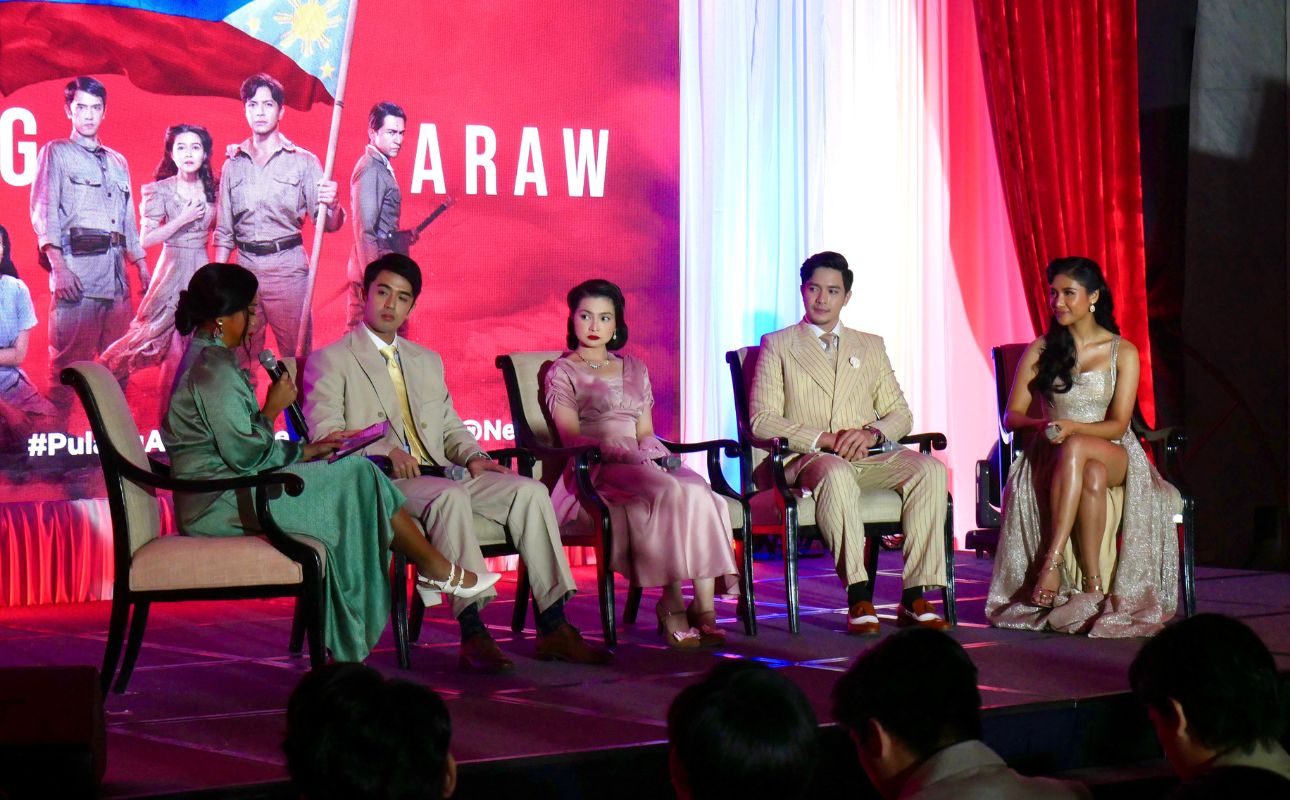The vibe was exceptionally like no other during “Pulang Araw’s” grand media conference at The Peninsula Manila in Makati City. It seemed as though invited knew of the gravitas of this war drama series– a Dominic Zapata-directed period drama whose events, while fictitious, are mainly inspired by the lived realities of Filipinos during the Japanese occupation.
During the main cast’s conversation with the press, Alden, Sanya, Barbie, and David could not help but be pensive, at times getting emotional while talking about the show’s historical concepts, and the rigor that was poured into the portrayal of such moving characters.
HISTORY AND FREEDOM
The beauty in creating characters for a war drama series like Pulang Araw is that, while fictitious, their cinematic arcs must exist against a backdrop of historical facts and true to life narratives.
Meaning, their tendencies cannot be simply fabricated. There are subtleties that matter, and there are nuances that heavily influence the story’s continuity.
“Hindi ko malilimutan yung sinabi ng aming direktor nung story conference, na kung anong kalayaan yung meron tayo ngayon, it is because of the people who went through hell during World War 2,” shared Alden.
“Yun yung pinanghawakan ko… bakit ‘di natin to ikwento, bat ‘di natin ‘to ilarawan sa mata ng nakakarami?” the Asia’s Multimedia Star added.
For Sanya, the show is a nod to the Filipino heroes whose lives were sacrificed for what freedom the Philippines is presently enjoying. “Ito’y pagbabalik-tanaw at respeto sa mga taong nakaranas ng hirap ng panahong yon… hindi para ibalik sa kanila yung sakit, kundi linawin sa bagong henerasyon kung gaano kahalaga yung history,” said the 27-year-old actress.
Barbie’s portrayal of Adelina dela Cruz was a huge eye-opener to the kind of entertainment that played a significant role in many Filipino communities during World War 2. “Malaki ang parte ng bodabil (vaudeville) na pagsasamahan namin ni Sanya. Napakakulay at napakalayo as mundo ng giyera”
The Primetime Princess’ character in “Pulang Araw” is the embodiment of “the show must go on.”
“Kahit anong problema o paghihirap, lahat iyon kakalimutan mo, ‘yun ang ibig sabihin ng bodabil. Tayo ay magbibigay ng aliw sa gitna ng kahirapan ng mga Pilipino noong pananakop ng Hapones. Napakaganda po ng bodabil sa programang ito,” marveled Barbie.
The series’ depiction of vaudeville as a significant source of entertainment during the Japanese occupation will be key in its pursuit of cultural relevance.
The characters being played by Barbie and Sanya will take the lead in symbolizing Filipino resiliency through the lens of bodabil’s colorful performances, dramatic skits, and unbreakable spirits.
“Regardless kung nagpe-perform ka, tutunog yung siren, may bombahan, titigil yung show, pero pag tapos na, perform ulit. Tuloy ang buhay. Pinilit nila nang ituloy ang pagperform at ang buhay despite the war,” described Alden.
CHARACTER WORK
Billed as the most important series of 2024, GMA Network’s “Pulang Araw” is being celebrated for all the right reasons reason. The pilot episode, lauded and cheered by an invited audience during an exclusive screening on Tuesday, was a reflection of an excellent character work, marked by thoroughly written characters and the rigorous portrayals that are about to bring them to life.
Alden recalled how difficult it was to do torture scenes, having to bear in mind that real Filipinos in the 1940s experienced these manifestations of oppression. “Meron kasing reality aspect yung Pulang Araw, alam mong nangyare talaga siya. Ang mahirap sa akin during that time, ay kung paano kumalas sa trauma.”
He revealed that he could not utilize his usual character switch, a common technique that typically enables him to detach freely from the character he is playing.
“Usually, on and off ako eh. Hindi naman ako nagdadala ng karakter after a certain taping day. Pero for some reason, itong Pulang Araw, paulit-ulit nagtatanong yung isip ko. Yung dinanas ng ating mga kapwa Pilipino– it is very emotional. It is very disturbing,” he explained.
For Alden, it was almost like a career first to experience such dilemma, something “I never thought I’d experience while doing Pulang Araw.”
“Kahit na inaarte lamang namin sya, nararamdaman namin yung trauma kasi yung setup, yung nasa loob kami ng isang dungeon— madilim, mausok, tapos tinotorture kami ng hapones,” he added.
Sanya, meanwhile, thinks of her character Teresita Borromeo as a stimulating reminder of the Filipino brand of resiliency that was in full display during such almost “hopeless situations.”
“Kung paano tayo nagkaroon ng freedom, kung paano ang Filipinos naging resilient nung panahon ng digmaan, nung panahon na halos hopeless yung situation natin,” she added.
She also believes in an important message derived from her understanding of Teresita’s character, “na kahit pa siya ay galing sa mayamang pamilya, andun yung trauma. Na nung panahon pala ng digmaan, walang mayaman walang mahirap.”
Barbie’s characterization of Adelina dela Cruz reminded her of the kind of happiness that only exists in childhood. “Kahit hindi siya (Adelina) nabigyan ng marangyang buhay, parang nasa kanila ang lahat, ganong level of happiness. Kitang-kita mo yung pagkabata– yung saya ng isang bata.”
“...hanggang sa mabuo yung kanyang pangarap na maging isang bodabil star, buong-buo yung childhood nya na hindi mo aakalain na lalaban siya sa giyera, at lalaban si Adelina,” marveled Barbie, who sounded very inspired and moved by her character’s nuances.
David’s main adversary was Hiroshi Tanaka’s draining list of internal conflicts. “It’s quite like a battle between the head and the heart, but ang pinaka-conflict talaga niya is yung pipiliin ba niya ay mga taong mahal niya, like Adelina, o ang bansa,” he reflected.
“For me, napakaganda nung conflicts. Napaka-challenging. Nung ginawa ko ito, ang laking preparation… napakahirap,” confessed Licauco.



